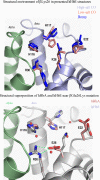Structural and functional studies indicating altered redox properties of hemoglobin E: implications for production of bioactive nitric oxide
- PMID: 21531715
- PMCID: PMC3123109
- DOI: 10.1074/jbc.M110.183186
Structural and functional studies indicating altered redox properties of hemoglobin E: implications for production of bioactive nitric oxide
Abstract
Hemoglobin (Hb) E (β-Glu26Lys) remains an enigma in terms of its contributions to red blood cell (RBC) pathophysiological mechanisms; for example, EE individuals exhibit a mild chronic anemia, and HbE/β-thalassemia individuals show a range of clinical manifestations, including high morbidity and death, often resulting from cardiac dysfunction. The purpose of this study was to determine and evaluate structural and functional consequences of the HbE mutation that might account for the pathophysiology. Functional studies indicate minimal allosteric consequence to both oxygen and carbon monoxide binding properties of the ferrous derivatives of HbE. In contrast, redox-sensitive reactions are clearly impacted as seen in the following: 1) the ∼2.5 times decrease in the rate at which HbE catalyzes nitrite reduction to nitric oxide (NO) relative to HbA, and 2) the accelerated rate of reduction of aquometHbE by L-cysteine (L-Cys). Sol-gel encapsulation studies imply a shift toward a higher redox potential for both the T and R HbE structures that can explain the origin of the reduced nitrite reductase activity of deoxyHbE and the accelerated rate of reduction of aquometHbE by cysteine. Deoxy- and CO HbE crystal structures (derived from crystals grown at or near physiological pH) show loss of hydrogen bonds in the microenvironment of βLys-26 and no significant tertiary conformational perturbations at the allosteric transition sites in the R and T states. Together, these data suggest a model in which the HbE mutation, as a consequence of a relative change in redox properties, decreases the overall rate of Hb-mediated production of bioactive NO.
Figures









Similar articles
-
HbE/β-Thalassemia and Oxidative Stress: The Key to Pathophysiological Mechanisms and Novel Therapeutics.Antioxid Redox Signal. 2017 May 10;26(14):794-813. doi: 10.1089/ars.2016.6806. Epub 2016 Nov 28. Antioxid Redox Signal. 2017. PMID: 27650096 Free PMC article. Review.
-
Crystal structures of HbA2 and HbE and modeling of hemoglobin delta 4: interpretation of the thermal stability and the antisickling effect of HbA2 and identification of the ferrocyanide binding site in Hb.Biochemistry. 2004 Oct 5;43(39):12477-88. doi: 10.1021/bi048903i. Biochemistry. 2004. PMID: 15449937
-
A transgenic mouse model expressing exclusively human hemoglobin E: indications of a mild oxidative stress.Blood Cells Mol Dis. 2012 Feb 15;48(2):91-101. doi: 10.1016/j.bcmd.2011.12.002. Epub 2012 Jan 18. Blood Cells Mol Dis. 2012. PMID: 22260787 Free PMC article.
-
Oxidative instability of hemoglobin E (β26 Glu→Lys) is increased in the presence of free α subunits and reversed by α-hemoglobin stabilizing protein (AHSP): Relevance to HbE/β-thalassemia.Redox Biol. 2016 Aug;8:363-74. doi: 10.1016/j.redox.2016.03.004. Epub 2016 Mar 10. Redox Biol. 2016. PMID: 26995402 Free PMC article.
-
Critical redox and allosteric aspects of nitric oxide interactions with hemoglobin.Antioxid Redox Signal. 2004 Dec;6(6):979-91. doi: 10.1089/ars.2004.6.979. Antioxid Redox Signal. 2004. PMID: 15548895 Review.
Cited by
-
Differential thermal stability and oxidative vulnerability of the hemoglobin variants, HbA2 and HbE.PLoS One. 2013 Nov 14;8(11):e81820. doi: 10.1371/journal.pone.0081820. eCollection 2013. PLoS One. 2013. PMID: 24244748 Free PMC article.
-
The capacity of red blood cells to reduce nitrite determines nitric oxide generation under hypoxic conditions.PLoS One. 2014 Jul 9;9(7):e101626. doi: 10.1371/journal.pone.0101626. eCollection 2014. PLoS One. 2014. PMID: 25007272 Free PMC article.
-
Ultrasensitive electrochemical molecularly imprinted sensor based on AuE/Ag-MOF@MC for determination of hemoglobin using response surface methodology.Anal Bioanal Chem. 2021 Aug;413(19):4895-4906. doi: 10.1007/s00216-021-03453-x. Epub 2021 Jul 8. Anal Bioanal Chem. 2021. PMID: 34236471
-
HbE/β-Thalassemia and Oxidative Stress: The Key to Pathophysiological Mechanisms and Novel Therapeutics.Antioxid Redox Signal. 2017 May 10;26(14):794-813. doi: 10.1089/ars.2016.6806. Epub 2016 Nov 28. Antioxid Redox Signal. 2017. PMID: 27650096 Free PMC article. Review.
-
Hemoglobin Variants as Targets for Stabilizing Drugs.Molecules. 2025 Jan 17;30(2):385. doi: 10.3390/molecules30020385. Molecules. 2025. PMID: 39860253 Free PMC article. Review.
References
-
- Giardine B., van Baal S., Kaimakis P., Riemer C., Miller W., Samara M., Kollia P., Anagnou N. P., Chui D. H., Wajcman H., Hardison R. C., Patrinos G. P. (2007) Hum. Mutat. 28, 206 - PubMed
-
- Forget B. H., Higgs D. R. (2009) in Disorders of Hemoglobin: Genetics, Pathophysiology, and Clinical Management (Steinberg M. H., Forget B. G., Higgs D. R., Weatherall D. J. eds) 2nd Ed., pp. 25–26, Cambridge University Press, New York
-
- Chotivanich K., Udomsangpetch R., Pattanapanyasat K., Chierakul W., Simpson J., Looareesuwan S., White N. (2002) Blood 100, 1172–1176 - PubMed
-
- Williams T. N. (2006) Curr. Opin. Microbiol. 9, 388–394 - PubMed
-
- Vichinsky E. (2007) American Society Hematology Education Program, pp. 79–83 - PubMed
Publication types
MeSH terms
Substances
Grants and funding
LinkOut - more resources
Full Text Sources
Miscellaneous

